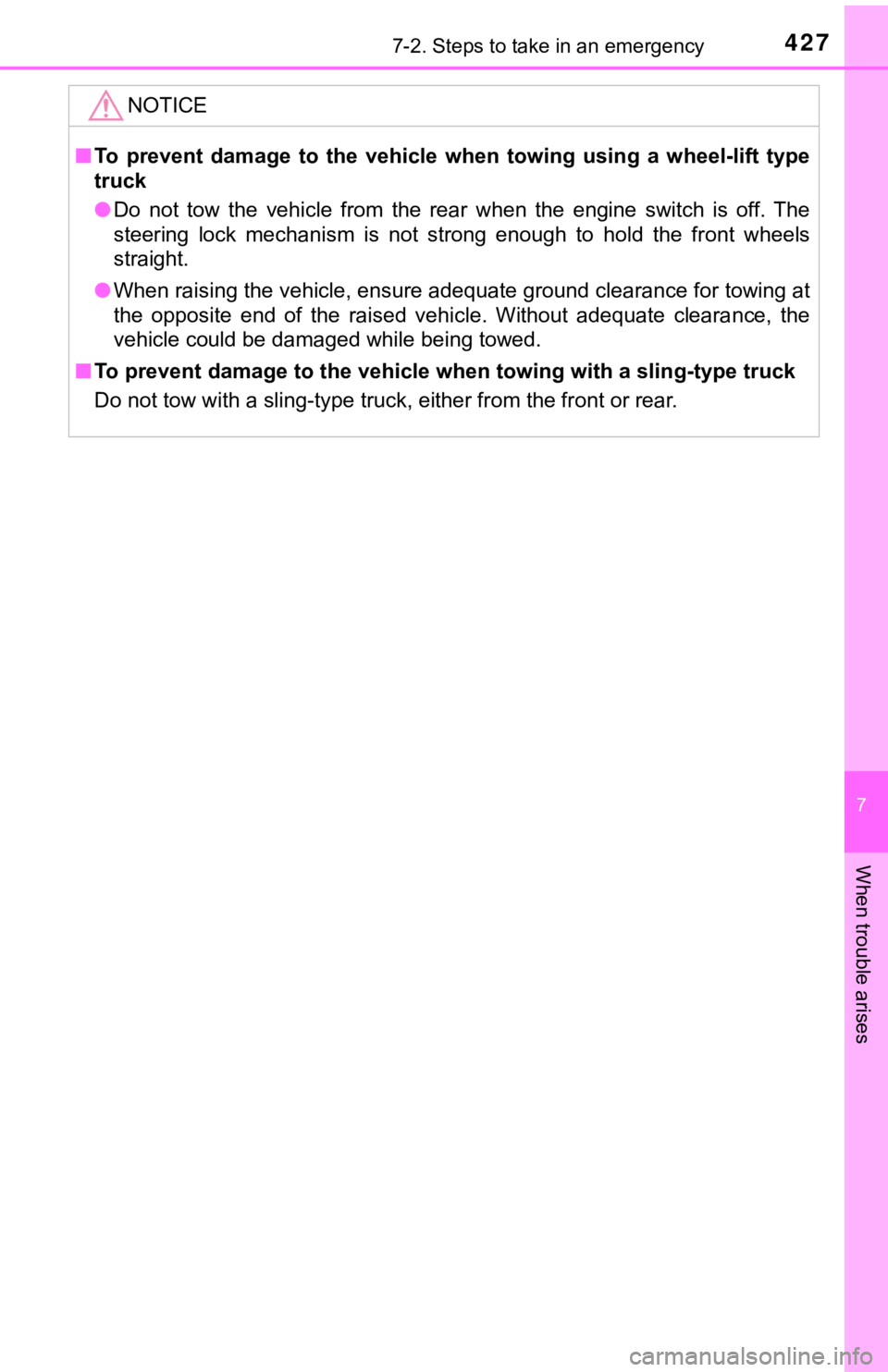tow TOYOTA AVALON 2020 (in English) Owner's Guide
[x] Cancel search | Manufacturer: TOYOTA, Model Year: 2020, Model line: AVALON, Model: TOYOTA AVALON 2020Pages: 540, PDF Size: 10.4 MB
Page 379 of 540

379
6
Maintenance and care
6-3. Do-it-yourself maintenance
Do-it-yourself ser vice precautions
If you perform maintenance by yourself, be sure to follow the
correct procedure as given in these sections.
ItemsParts and tools
Battery condition
( P. 390)• Warm water• Baking soda• Grease
• Conventional wrench (for terminal clamp bolts)
Brake fluid level
( P. 389)
• SAE J1703 or FMVSS No.116 DOT 3
SAE J1704 or FMVSS No.116 DOT 4
• Rag or paper towel
• Funnel (used only for adding brake fluid)
Engine coolant
level ( P. 387)
• “Toyota Super Long Life Coolant” or a similar high
quality ethylene glycol-based non-silicate, non-
amine, non-nitrite and non-borate coolant with long-
life hybrid organic acid technology
U.S.A.:
“Toyota Super Long Life Coolant” is pre-mixed with
50% coolant and 50% deionized water.
Canada:
“Toyota Super Long Life Coolant” is pre-mixed with
55% coolant and 45% deionized water.
• Funnel (used only for adding engine coolant)
Engine oil level
( P. 384)• “Toyota Genuine Motor Oil” or equivalent
• Rag or paper towel
• Funnel (used only for adding engine oil)
Fuses ( P. 416)• Fuse with same amperage rating as original
Radiator/con-
denser (
P. 388)
Tire inflation
pressure
( P. 407)• Tire pressure gauge
• Compressed air source
Washer fluid
( P. 392)• Water or washer fluid containing antifreeze (for win-
ter use)
• Funnel (used only for adding water or washer fluid)
Page 400 of 540

4006-3. Do-it-yourself maintenance
●Performance may be affected in the following situations.
• When driving near a TV tower, electric power plant, gas station, radio
station, large display, airport or other facilit y that generates strong
radio waves or electrical noise
• When carrying a portable radio, cellular phone, cordless phone or
other wireless communication device
If tire position information is not correctly displayed due to the radio
wave conditions, the display ma y be corrected by changing the l ocation
of the vehicle as the radio wa ve conditions may change.
●When the vehicle is stopped, the time taken for the warning to start or
turn off may be longer.
●When the inflation pressure of a tire drops rapidly, for exampl e when a
tire has burst, the warning may not operate.
■Initialization procedure
●Make sure to perform the initialization procedure after adjusti ng the tire
inflation pressure.
Also, make sure the tires are cold before performing the initia lization
procedure or adjusting the tire inflation pressure.
●If the engine switch is turned off during initialization, it is not necessary
to restart the initialization procedure from the beginning as i t will begin
automatically when the engine switch is turned back to IGNITION ON
mode.
●If initialization has accidentally been started when it is not necessary,
adjust the tire inflation pressu re to the specified level when the tires are
cold and then perform the ini tialization procedure again.
●While the position of each tire is being determined and the inf lation pres-
sures are not being displayed on the multi-information display, if the
inflation pressure of a tire drops, the tire pressure warning l ight will come
on.
■Warning performance of the tire pressure warning system
The warning of the tire pressu re warning system will change in accor-
dance with the conditions under which it was initialized. For t his reason,
the system may give a warning even if the tire pressure does no t reach a
low enough level, or if the pressure is higher than the pressur e that was
adjusted to when the sys tem was initialized.
Page 421 of 540

421
7When trouble arises
7-1. Essential informationEmergency flashers .......... 422
If your vehicle has to be stopped in
an emergency ................. 423
If the vehicle is trapped in rising water.................. 424
7-2. Steps to take in an emergency
If your vehicle needs to be towed ......................... 425
If you think something is wrong .............................. 428
Fuel pump shut off system ............................ 429
If a warning light turns on or a warning buzzer
sounds ............................ 430
If a warning message is displayed......................... 440
If you have a flat tire.......... 445
If the engine will not start ................................. 457
If the electronic key does not operate properly........ 459
If the vehicle battery is discharged ...................... 462
If your vehicle overheats ........................ 466
If the vehicle becomes stuck ............................... 469
Page 425 of 540

425
7
When trouble arises
7-2. Steps to take in an emergency
The following may indicate a problem with your transmission. Contact
your Toyota dealer or commercial towing service before towing.
● The engine is running but t he vehicle does not move.
● The vehicle makes an abnormal sound.
Do not tow with a sling-type truck
to prevent body damage.
If your vehicle needs to be towed
If towing is necessary, we recommend having your vehicle
towed by your Toyota dealer o r commercial towing service,
using a wheel-lift type t ruck or flatbed truck.
Use a safety chain system for all towing, and abide by all stat e/
provincial and local laws.
Situations when it is necessary to contact dealers before towing
Towing with a sling-type truck
Towing with a wheel-lift type truck
From the frontFrom the rear
Release the parking brake. Us e a towing dolly under the
front wheels.
Page 426 of 540

4267-2. Steps to take in an emergency
If your vehicle is transported by a
flatbed truck, it should be tied
down at the locations shown in the
illustration.
Covers are installed to the tie-down
holes. After transporting the vehi-
cle, make sure to reinstall the cov-
ers to the holes.
If you use chains or cables to tie
down your vehicle, the angles
shaded in black must be 45.
Do not overly tighten the tie
downs or the vehicle may be dam-
aged.
Using a flatbed truck
Front
WARNING
Observe the following precautions.
Failure to do so may result in death or serious injury.
■ When towing the vehicle
Be sure to transport the vehicle with the
front wheels raised or with all four wheels
raised off the ground. If the vehicle is
towed with the front wheels contacting
the ground, the drivetrain and related
parts may be damaged.
Page 427 of 540

4277-2. Steps to take in an emergency
7
When trouble arises
NOTICE
■To prevent damage to the vehicle when towing using a wheel-lift type
truck
● Do not tow the vehicle from the rear when the engine switch is off. The
steering lock mechanism is not strong enough to hold the front wheels
straight.
● When raising the vehicle, ensure adequate ground clearance for towing at
the opposite end of the raised vehicle. Without adequate clearance, the
vehicle could be damaged while being towed.
■ To prevent damage to the vehicle when towing with a sling-type truck
Do not tow with a sling-type truck, either from the front or re ar.
Page 449 of 540

4497-2. Steps to take in an emergency
7
When trouble arises
Secure the luggage floor cover
using the hook provided.
Remove the tool tray.
Loosen the center fastener that
secures the spare tire.
When taking out or stowing the
spare tire, make sure to firmly
hold opposite end of the tire.
2
3
4
WARNING
■When storing the spare tire
Be careful not to catch fingers or other body parts between the spare
tire and the body of the vehicle.
Page 453 of 540

4537-2. Steps to take in an emergency
7
When trouble arises
Remove any dirt or foreign mat-
ter from the wheel contact sur-
face.
If foreign matter is on the wheel
contact surface, the wheel nuts
may loosen while the vehicle is in
motion, causing the tire to come
off.
Install the tire and loosely tighten each wheel nut by hand by
approximately the same amount.
Tighten the wheel nuts until the
tapered portion comes into loose
contact with the disc wheel seat.
Lower the vehicle.
Firmly tighten each wheel nut
two or three times in the order
shown in the illustration.
Tightening torque:
76 ft•lbf (103 N•m, 10.5 kgf•m)
Stow the flat tire, tire jack and all tools.
Installing the spare tire
1
2
Tapered portion
Disc wheel
seat
P
Q
R
Page 470 of 540

4707-2. Steps to take in an emergency
■When it is difficult to free the vehicle
Press to turn off TRAC.
WARNING
■ When attempting to f ree a stuck vehicle
If you choose to push the vehicle back and forth to free it, ma ke sure the
surrounding area is clear to avoid striking other vehicles, obj ects or people.
The vehicle may also lunge forward or lunge back suddenly as it becomes
free. Use extreme caution.
■ When shifting the shift lever
Be careful not to shift the shift lever with the accelerator pe dal depressed.
This may lead to unexpected rapid acceleration of the vehicle t hat may
cause an accident resulting in death or serious injury.
NOTICE
■ To avoid damaging the transmission and other components
● Avoid spinning the front wheels and depressing the accelerator pedal
more than necessary.
● If the vehicle remains stuck even after these procedures are pe rformed,
the vehicle may require towing to be freed.
Page 527 of 540

527Alphabetical index
Child safety ................................ 55Airbag precautions .................. 39
Battery precautions ....... 391, 465
Child restraint system ............. 56
How your child should wear the seat belt .......................... 32
Installing child restraints ......... 60
Moon roof precautions .......... 167
Power window lock switch .... 160
Power window precautions ... 163
Rear door child-protectors .... 128
Removed electronic key battery precautions ............. 415
Seat belt extender precautions ........................... 35
Seat belt precautions .............. 34
Seat heater precautions........ 329
Trunk precautions ................. 133
Child-protectors....................... 128
Cleaning ........................... 366, 369
Aluminum wheels.................. 367
Exterior ................................. 366
Interior................................... 369
Seat belts .............................. 370
Coat hooks ............................... 356
Condenser ................................ 388
Console box ............................. 336
Consumption
screen............................... 97, 116
Coolant Capacity ................................ 476
Checking ............................... 387
Preparing and checking before winter....................... 316
Cooling system ........................ 387 Engine overheating ............... 466
Cornering lights ....................... 203
Cruise control
Dynamic radar cruise control with full-speed range .......... 248 Cup holders ............................. 338
Curtain shield airbags............... 37
Customizable features ............ 497
Customized mode ................... 305
Daytime running light
system.................................... 204
Defogger Outside rear view mirrors ..... 324
Rear window ......................... 324
Windshield ............................ 324
Dimensions .............................. 472
Dinghy towing.......................... 183
Display Dynamic radar cruise control
with full-speed range .......... 248
LDA (Lane Departure Alert with steering control) .......... 243
Multi-information display ......... 93
Warning messages ............... 440
Do-it-yourself maintenance .... 379
Door courtesy lights
Location ................................ 332
Wattage ................................ 480
Door lock Doors .................................... 125
Smart key system ................. 125
Wireless remote control ........ 125
Doors ........................................ 125 Automatic door locking
and unlocking systems ....... 128
Door lock .............................. 127
Outside rear view mirrors ..... 157
Rear door child-protector ...... 128
Side doors ............................ 125
Side windows........................ 160
Drive-Start Control .................. 171
Driver’s seat belt reminder light ........................ 433
D